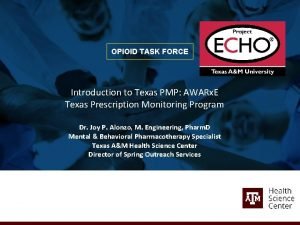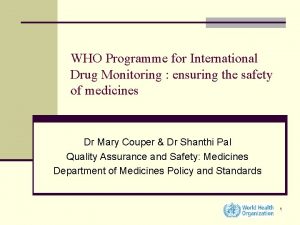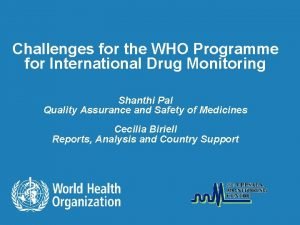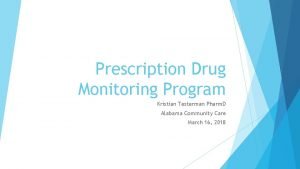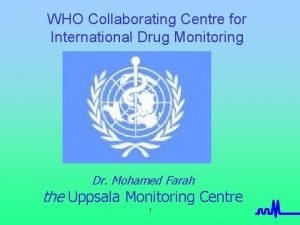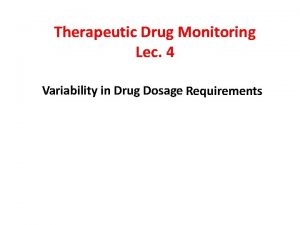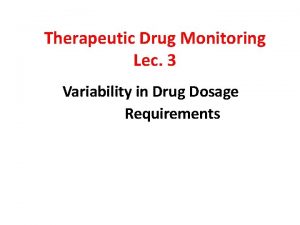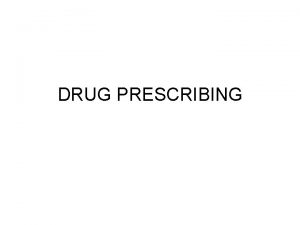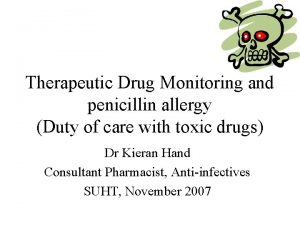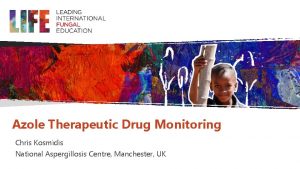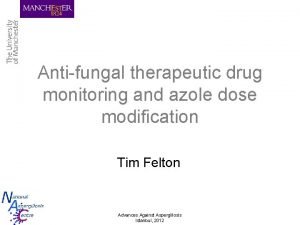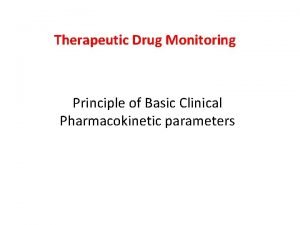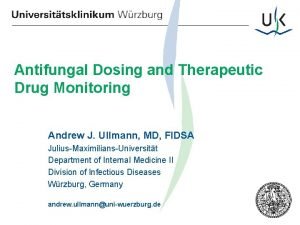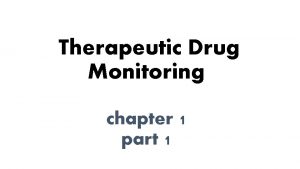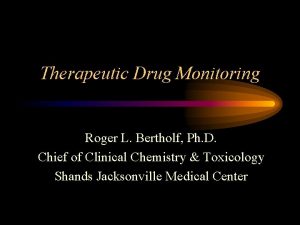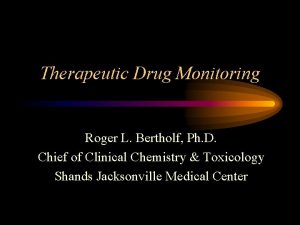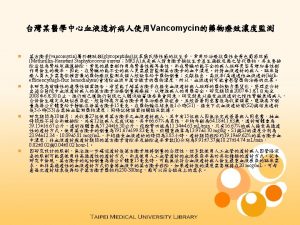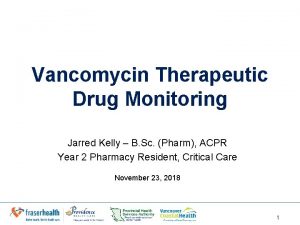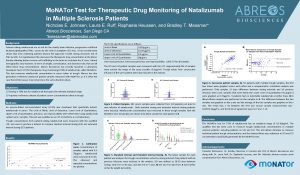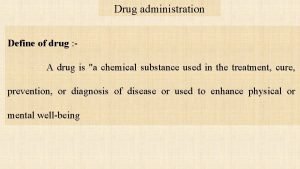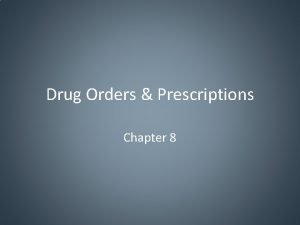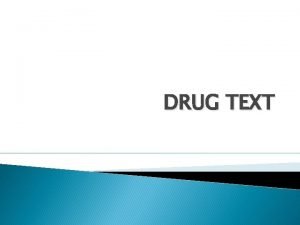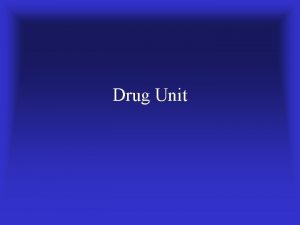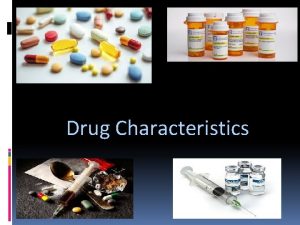Therapeutic Drug Monitoring Therapeutic drug monitoring Involves the



























- Slides: 27

Therapeutic Drug Monitoring

Therapeutic drug monitoring • Involves the analysis, assessment and evaluation of circulating concentrations of drugs in serum, plasma, or whole blood. • Purpose is to ensure the medication dose is at therapeutic range and not toxic. • Medications dosage differ between each patient based on metabolic process. • Therapeutic range is narrow for some drugs – below range: drug not effective – above rang: drug toxic 2

Indications of TDM • The consequences of overdosing and underdosing are serious. • There is a small difference between a therapeutic and toxic dose. • There is a change in the patient's physiologic state that may unpredictably affect circulating drug concentrations. • A drug interaction may be occurring. • TDM helps in monitoring patient compliance. 3

Routes Of Administration • For a drug to express a therapeutic benefit, it must be at the appropriate concentration at its site of action. • Measuring drug concentration at the site of action would be ideal. • Unfortunately, for most drugs, this cannot be done. • The circulatory system offers a convenient route that can effectively deliver most drugs to its site of action • The goal of most therapeutic regimens is to acquire a blood, plasma, or serum concentration that has been correlated with an effective concentration at the site of action 4

Routes of Administration • Each presents with different characteristics that influence circulating concentrations 1. Orally (most common) 2. Rectally 3. Intravenous (IV)/ intramuscular (IM) 4. subcutaneous 5. Inhalation 6. or absorbed through the skin 5

Biological effect • • • A drug is effective when it binds to a specific receptor in the target tissue. TDM assumes that serum levels are proportional to the intercellular tissue bind capacity of the drug. Drug utilization in the body is influenced by: 1. 2. 3. 4. Absorption Distribution Metabolism Excretion 6

Absorption • The efficiency of drug absorption from GIT is dependent on many factors: o Tablets and capsules require dissolution before being absorbed. o Liquid solutions are more rapidly absorbed. o Weak acids are efficiently absorbed in the stomach. o Weak bases are absorbed in the intestine. o Changes in intestinal motility, p. H, inflammation, as well as food or other drugs may dramatically change absorption characteristics. 7

Absorption – All substances, including drugs, absorbed from the intestine enter the hepatic portal system, – certain drugs are subject to significant hepatic uptake and metabolism (first-pass metabolism) – this process is known as Characteristics of drug may change in pregnancy, age …. . etc • With the use of TDM, effective dosage treatment can be determined. 8

Distribution • Once drug is absorbed into the blood, it begins to distribute to tissues • The amount of drug that partitions into tissues depends on: – Solubility – Protein binding • The partitioning of drug between blood and tissues is expressed quantitatively as the Volume of Distribution 9

Excretion • Hepatic metabolism or renal filtration, or a combination of the two, eliminates most drugs. • Functional changes in these organs may result in changes in the rate of elimination. • Half-life represents the time needed for the serum concentration to decrease by one half. 10

Metabolic Clearance • Most drugs are xenobiotics – substances not normally found within human system, yet capable of entering biochemical pathways intended for endogenous substances. • The biochemical pathway responsible for a large portion of drug metabolism is the hepatic mixed function oxidase "MFO" system. 11

Metabolic clearance • The basic function of MFO system involves taking hydrophobic substances and through a series of enzymatic reactions converting them into watersoluble substances. • These products are then either pumped into the bile or released into the general circulation, where they are eliminated by renal filtration. 12

Excretion - Renal • Kidneys are the primary excretory organ. • In Renal disease – other excretory organs or pathway become involved such as: biliary tract, lungs and sweat glands. • H 2 O soluble drugs excrete faster than insoluble. • Decreases in glomerular filtration rate directly results in increased serum half-life and concentration 13

Drugs commonly measured A. Cardiac medications (digoxin) B. Antibiotics (amikacin, gentamicin, vancomycin) C. Antiepileptic drugs (phenobarbital) D. Psychoactive Drugs (lithium) E. Immunosuppressants (Cyclosporine) F. Antineoplastics (Methotrexate) 14

Sample Collection • For most drugs, sample is collected right before the next dose. • Peak concentrations are drawn 1 h after an orally administered dose. • Some drugs "e. g digoxin" are absorbed slowly and require several hours before peak drug levels can be evaluated. • In all situations, determination of serum concentrations should be done only after steady state has been achieved. • Serum or plasma is the specimen of choice for most drugs. 15

A. Cardiac medication • Medication that is used to treat various heart diseases. 1. Digoxin: • cardiac glycoside used for CHF. • Function by inhibiting membrane Na, K, • • ATPase pump. ↓ intracellular K+ → ↑ Ca++ improves cardiac contraction. 16

A. Cardiac medication- Digoxin • • • ↑ conc. → toxic effects include: • • premature ventricular contractions "PVCs" and atrioventricular node blockage Therapeutic range: 0. 8 -2 ng/m. L Absorption orally is variable and is influenced by dietary factors and formulation of the drug Elimination occurs by renal filtration Digoxin is measured in serum using immunoassay. 17

A. Cardiac medication 2 - Lidocaine • Used to correct ventricular arrhythmias and preventricular fibrillation. • Completely eliminated by the liver if orally given as monoethylglycinexylidide (MEGX). • Therapeutic range: 1. 5 - 4. 0 µg/ml • Toxic effects include CNS depression 18

B. Antibiotics 1. Aminoglycosides: – treat infection with gram negative bacteria. – Gentamycin, tobramycin, amikacin, and kanamycin – Therapeutic range 4 - 10 g/m. L – Toxicity involve; nephrotoxicity and ototoxicity (ear) and effects balance and hearing. – Eliminated by renal system – Chromatography and immunoassay 19

B. Antibiotics 2. Vancomycin – Glycopeptides: effective against Gram positive cocci and bacilli. – Poor oral absorption, given IV. – Therapeutic range: 5 -10 µg/ml – Toxicity: kidney, ototoxicity, Red-man syndrome( flushing of skin of the extremities) – Eliminated by renal excretion – It is assayed by immunoassay and chromatographic methods. 20

C. Antiepileptic drugs • Used to treat epilepsy seizures and convulsions on a prophylactic bases. • Phenobarbital: – is a barbiturate that is absorbed slowly orally and has a long half-life. – Primidone is its preform (inactive)- rapidly absorbed and converted into the active form. – Therapeutic range: 15 - 40 ng / ml – Toxicity: drowsiness, fatigue and depression 21

D. Psychoactive Drugs • Lithium: – Used to treat manic-depression (bipolar disorder). – Absorption is complete and rapid. – Distribution is uniform throughout the body. – Eliminated by renal function. – Therapeutic range: 0. 8 – 1. 2 mmol/l – Toxicity: cause apathy, speech difficulty's and muscle weakness. 22

E. Immunosuppressive drugs • Used to prevent rejection in various organ transplantation procedures. • Cyclosporin: – cyclic polypeptide used to prevent GVHD. – It is eliminated by hepatic metabolism to inactive products. – The dose is dependent on the organ transplanted, cardiac, liver, or pancreas transplants 23

Cyclosporin: – Toxic effects when blood concentration ranges from 350 -400 ng/ml. – Toxic effects are primarily renal tubular and glomerular dysfunction. – Determination using immunoassays and chromatographic methods. 24

F. Antineoplastics • Used to treat neoplastic disorders (cancer) • Methotrexate: – inhibits DNA synthesis in all cells. – Neoplastic cells, as a result of their rapid rate of division, • have a higher requirement for DNA • and are susceptible to deprivation of this essential constituent before normal cells. 25

Methotrexate: – The efficacy of therapy is dependent on a controlled period of inhibition, one that is selectively detrimental to neoplastic cells. – This is accomplished by the administration of leucovorin, which reverses the actions of methotrexate at a specific time after methotrexate infusion. – This is referred to as leucovorin rescue. 26

Methotrexate: – Failure to stop methotrexate actions results in cytotoxic effects to most cells. – Evaluation of serum methotrexate concentration, after the inhibitory time period has passed, is used to: • determine how much leucovorin is needed to counteract many of the toxic effects of methotrexate. 27
 Example of substitution with exhausted drug is
Example of substitution with exhausted drug is Texas pmp aware
Texas pmp aware Who program for international drug monitoring
Who program for international drug monitoring Who programme for international drug monitoring
Who programme for international drug monitoring Alabama prescription drug monitoring program
Alabama prescription drug monitoring program Who collaborating centre for international drug monitoring
Who collaborating centre for international drug monitoring Lời thề hippocrates
Lời thề hippocrates Thang điểm glasgow
Thang điểm glasgow đại từ thay thế
đại từ thay thế Quá trình desamine hóa có thể tạo ra
Quá trình desamine hóa có thể tạo ra Công thức tiính động năng
Công thức tiính động năng Sự nuôi và dạy con của hươu
Sự nuôi và dạy con của hươu Thế nào là mạng điện lắp đặt kiểu nổi
Thế nào là mạng điện lắp đặt kiểu nổi Các loại đột biến cấu trúc nhiễm sắc thể
Các loại đột biến cấu trúc nhiễm sắc thể Thế nào là sự mỏi cơ
Thế nào là sự mỏi cơ Bổ thể
Bổ thể Vẽ hình chiếu đứng bằng cạnh của vật thể
Vẽ hình chiếu đứng bằng cạnh của vật thể độ dài liên kết
độ dài liên kết Thiếu nhi thế giới liên hoan
Thiếu nhi thế giới liên hoan điện thế nghỉ
điện thế nghỉ Chúa sống lại
Chúa sống lại Một số thể thơ truyền thống
Một số thể thơ truyền thống Trời xanh đây là của chúng ta thể thơ
Trời xanh đây là của chúng ta thể thơ Số nguyên tố là số gì
Số nguyên tố là số gì đặc điểm cơ thể của người tối cổ
đặc điểm cơ thể của người tối cổ Tỉ lệ cơ thể trẻ em
Tỉ lệ cơ thể trẻ em Vẽ hình chiếu vuông góc của vật thể sau
Vẽ hình chiếu vuông góc của vật thể sau Các châu lục và đại dương trên thế giới
Các châu lục và đại dương trên thế giới

